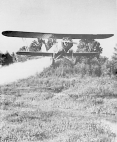 Biomedical Research
Biomedical Research
Notable Contributions to Biomedical Research
The many significant contributions of Public Health Service scientists to the development of the biomedical sciences and to the improvement of the public health cannot be summarized easily.
The major research endeavors during the early years were the diagnosis and study of infectious diseases, standardization and regulation of biologic products, the development of vaccines, the study of anaphylaxis or hypersensitivity to drugs, chemical tests for blood, the chemistry of vitamins, stream pollution, occupational health, and industrial hygiene. The aim was to apply science to the basic problems of health. The objectives were usually very practical in nature.
Joseph Kinyoun and his colleagues in New York City, for example, were the first in the United States in 1887 to make a bacteriological diagnosis of cholera. Studies in the South during the first half of the 20th century of the hookworm disease by Charles Stiles and of pellagra by Joseph Goldherger clearly demonstrated the relationship between poor living conditions, meager diet, and disease, and they helped stimulate full-time county health work. Epidemiological studies of typhoid fever in Washington, D.C., and elsewhere during 1906-10 by Leslie Lumsden contributed to the development of the rural sanitation movement.
After World War II the focus of research shifted to the study of chronic diseases, such as those of the heart and kidneys, cancer, arthritis, the neurological disorders, diseases of the eye and the teeth, health problems associated with aging, child health, and environmental health. Great emphasis has been placed on the study of human biology: immunology, genetics, cellular and molecular biology. The National Institutes of Health have played an important role in the development of recombinant DNA technology, which has given birth to genetic engineering and the new biotechnology industry.
NIH scientists have won Nobel Prizes for deciphering the genetic code, for work on the three-dimensional structure of proteins, for discovering how brain cells communicate with one another, and for work on slow viruses. They are at the forefront of research on AIDS.
Gallery
Through brilliant field investigations of orphanages, insane asylums, and prison farms in the South during the 1910s and early 1920s, Joseph Goldberger (1874-1929) demonstrated that pellagra, which killed thousands of mostly poor people yearly, was caused by a nutritional deficiency resulting from an unbalanced diet and could be cured by the addition of fresh milk, meat, or yeast. The deficient nutrient was identified in 1937 as niacin, a member of the vitamin B complex.
c. 1910
Dr. Joseph Goldberger and his young assistant, Dr. William Henry Sebrell, Jr., who was appointed director of the National Institutes of Health in 1950, working on pellagra at the Hygienic Laboratory.
c. 1926
A family, mother and children, all suffering from pellagra, which caused the skin to turn red and then scaly. Stomach disorders, diarrhea, and depression followed. Victims often became insane.
c. 1920
A poor diet of hominy grits, mush, molasses, cabbages, potatoes, and rice was the main cause of pellagra.
c. 1920
The diet laboratory where extensive research was carried out to establish that pellagra was caused by a dietary deficiency.
c. 1920
Nurses Bullard, Ferguson, and Norsdoff at a temporary yellow fever hospital in Franklin, Louisiana. Fast action by Dr. Henry R. Caner, who arranged the establishment of a detention camp, temporary hospital, and train inspection service, averted a major outbreak of yellow fever like the one in 1878 that swept up the Mississippi River claiming 20,000 lives. The last outbreak of yellow fever in the United States occurred at New Orleans in 1905.
1898
Henry R. Carter (1852-1925), the yellow fever expert of the Public Health Service, collecting mosquito larvae at Baden Pond in North Carolina. His discovery of the extrinsic incubation period of yellow fever in 1898 led to the determination of the role of the mosquito in the transmission of the yellow fever virus.
c. 1924
Thomas Parran (1892-1968) was a strong national and international leader in the field of public health. As chief of the Public Health Service's Division of Venereal Diseases (1926-30) and as Surgeon General (1936-48) he led the fight against venereal disease, with special emphasis on public education. He greatly strengthened and extended the research programs at the National Institutes of Health, established the Communicable Disease Center (later Centers for Disease Control and Prevention in Atlanta, Georgia), and participated in the planning of the World Health Organization.
c. 1930
The first definite work of the Public Health Service in the control of venereal diseases began during World War I. An act of Congress in 1918 created a Division of Venereal Diseases in the Public Health Service and appropriated two million dollars for the prevention, control, and treatment of venereal diseases. Posters, such as this one, were a very popular form of health education.
c. 1940
State and local health departments planned and conducted campaigns to find persons with venereal disease and bring them for treatment, either in their own clinics or by private physicians. These departments also provided the diagnostic and laboratory services necessary in venereal disease control. The Public Health Service aided the states to finance and administer their control programs.
c. 1945
The two-story empty school building in Hamilton, Montana, which in 1922 became the U.S. Public Health Service Laboratory for research on Rocky Mountain spotted fever. Here bacteriologist Roscoe R. Spencer (1888-1982) of the Hygienic Laboratory and Montana entomologist, Ralph R. Parker (1888-1949), worked through the summer tick seasons of 1922 to 1928 developing a vaccine. Dr. Spencer gave himself the first human vaccination against spotted fever in 1924.
c. 1925
Men being tested for spotted fever by scientists from the Rocky Mountain Laboratory in Hamilton, Montana. Spotted fever, a rickettsial disease transmitted by ticks, was taking a devastating toll of western settlers when the Hygienic Laboratory first sent Dr. Julius O. Cobb in 1902 to the Bitter Root Valley in Montana to investigate.
c. 1930
Much joint research by bacteriologists and entomologists had to be done at the Rocky Mountain Laboratory on ticks and guinea pigs before a successful vaccine against spotted fever was developed. The results of the Spencer-Parker vaccine were impressive. Before vaccination began in the spring of 1925, the mortality from spotted fever in the Bitter Root Valley had ranged between 80 and 90 percent. Between 1927 and 1940 half a million people in the Rocky Mountain region were vaccinated. Of these, only 61 developed spotted fever and only three died.
c. 1935
After its successful work with spotted fever the Rocky Mountain Laboratory expanded its facilities and programs in the 1940s and 1930s to work on other insect-borne diseases, such as yellow fever and the spirochetal relapsing fevers. In 1979, the Laboratory was reorganized and its name made plural -- the Rocky Mountain Laboratories -- because it now consisted of three laboratories: the Laboratory of Microbial Structure and Function, the Laboratory of Persistent Viral Diseases, and the Laboratory of Pathobiology.
c. 1951
Bubonic plague first struck the continental United States at San Francisco in March of 1900. The presence of this contagious and often fatal epidemic disease was verified bacteriologically by Dr. Joseph Kinyoun, who had been the first director of the Hygienic Laboratory and now was in charge of the U.S. Quarantine Station at San Francisco. Quarantine measures that were instituted, including fumigation and sterilization, provoked violent criticism and protest in the local community. The Service responded by creating a special plague commission of eminent medical researchers from academia, who went to San Francisco in 1901 and confirmed the existence of plague, by establishing a Plague Laboratory in the city, and by sending Dr. Rupert Blue, who later became Surgeon General (1912-1920), to head the plague control work. Plague was first proclaimed eradicated in 1905 (after 121 cases and 113 deaths), but struck again in 1907 as a result of the San Francisco earthquake. A luncheon by the Citizen's Health Committee of San Francisco in 1908, pictured here, commemorated the completion of the plague control campaign. Its slogan was: "San Francisco is so clean a meal can be eaten in the streets." Dr. Rupert Blue was guest of honor.
c. 1908
Controlling the spread of bubonic plague became a very important task for the Public Health Service at the turn of the twentieth century. Under the leadership of Dr. Rupert Blue (1867-1948) a major outbreak of urban bubonic plague in San Francisco, which started in 1900, was brought under control. But the infection, transmitted by flea-infected rats, had spread from rats to ground squirrels. A campaign of killing ground squirrels to obtain information on the presence of plague infection, which is pictured here, was started by Dr. Blue in rural areas around San Francisco in 1909 and then was extended to other areas of California and to other states.
c. 1910
Bubonic plague appeared in New Orleans in 1914. State and city authorities immediately requested the Public Health Service to take charge of the plague control operations. Since it was now known that the disease was transmitted by fleas from infected rats, rat-trappers, such as these, would set baited traps all around the city and then visit them twice daily. The trapped rats were removed, labeled with the specific address at which they were caught, placed in galvanized buckets or cloth bags, and returned to the laboratory where the laboratory workers would examine them for signs of plague infection. The daily total could run as high as 4,000 to 5,000 rats.
c. 1914
A Public Health Service survey in 1912 found that trachoma was prevalent in the rural mountains of Kentucky. Dr. John McMullen, who conducted that survey and who had extensive experience in the surgical treatment of trachoma from his work with immigrants at Ellis Island, New York, was assigned by the Service to begin trachoma control work in Kentucky. The goal was to find and treat existing cases and to prevent new ones through health education, especially encouraging improvement in personal hygiene. To help in this work, small temporary hospitals of 20-30 beds, such as this one in Jackson, Kentucky, were established throughout the area. The professional staff of each hospital consisted of one physician trained in diseases of the eye, and from two to four nurses.
c. 1916
Trachoma was also found in the Ozark mountain area of Missouri and a trachoma hospital was established in Rolla, Missouri. Pictured here are the examining and waiting rooms of the Rolla hospital. Bacteriologist Ida Bengston was sent here about 1922 from the Hygienic Laboratory in Washington, D.C., and spent several years trying to find the cause of trachoma.
c. 1930
From its inception the Hygienic Laboratory played a major role in the study of water-borne diseases such as cholera and typhoid fever. The Laboratory's bacteriological experts conducted many studies of the biochemistry of sewage and industrial wastes to isolate and identify the causative organisms, and devised better physical methods for treating various kinds of waste. In 1913 the Public Health Service opened a laboratory in Cincinnati devoted exclusively to the study of water pollution.
c. 1930
Frequent explosive outbreaks of typhoid fever in urban areas and the high morbidity and mortality rates in cities attributed to water supplies forced the nation's attention in the early 1900s to the pollution of rivers and lakes. Congress enacted a law in 1912 authorizing the Public Health Service to conduct investigations of pollution of navigable waters. A small group of sanitary engineers, medical officers, chemists, biologists, and bacteriologists was assembled by the Public Health Service in the summer of 1913 to begin the study of stream pollution. Dr. Wade H. Frost (1880-1938) and Dr. Leslie L. Lumsden (1875-1946) were leaders in this effort.
c. 1915
Malaria has been a major scourge throughout much of American history, particularly in the South. A family sitting on an unscreened porch in the early evening was at risk to malaria from mosquito bites. Eliminating mosquito-breeding areas by draining swamps and applying a mixture of kerosene and crude oil together with extensive screening of houses and the use of quinine helped bring malaria under control.
c. 1920
The first large-scale engineering operations to control malaria in the United States began in the second decade of the twentieth century. Previous mass-killings of malaria mosquitos had been undertaken only in relatively small demonstration areas, in Cuba and in the Panama Canal Zone. The airplane became an important tool for dispersing insecticides in the battle against malaria and other insect-borne diseases.
c. 1930



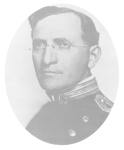
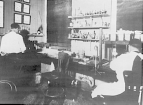
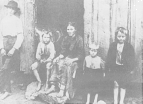
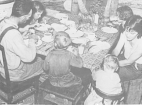
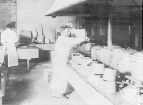
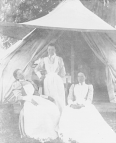
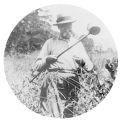
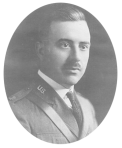

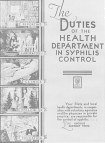
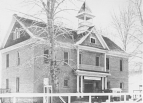
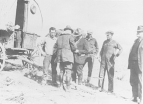
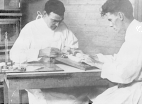
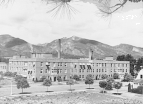
![Luncheon by the Citizen's Health Committee of San Francisco in 1908 commemorating the completion of the plague control campaign, c. 1908. Image A029486 from Images from the History of Medicine (IHM) Photograph of a luncheon held outdoors. Rows of men in bowler hats and suits and women in formal wear and hats are shown at long tables positioned on a street in San Francisco. Several buildings appear in the background, including one, with a sign [G]eorge J. Ellington on its roof.](images.dir/small_73.gif)
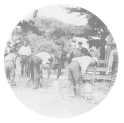
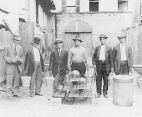
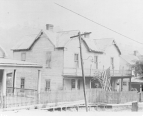
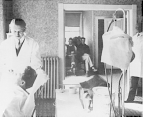
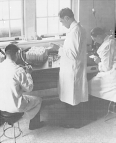
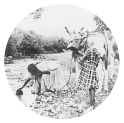
![Sitting on the front porch after a hard day's work may be a dangerous form of relaxation .. [Photo by Marthey]. Image A018706 from Images from the History of Medicine (IHM) A rural family sitting on the porch of a shack in early evening; one man plays a guitar and a little girl holds a doll. Evening is feeding time for mosquitoes; the family is susceptible to malaria in this mosquito infested area.](images.dir/small_80.gif)
